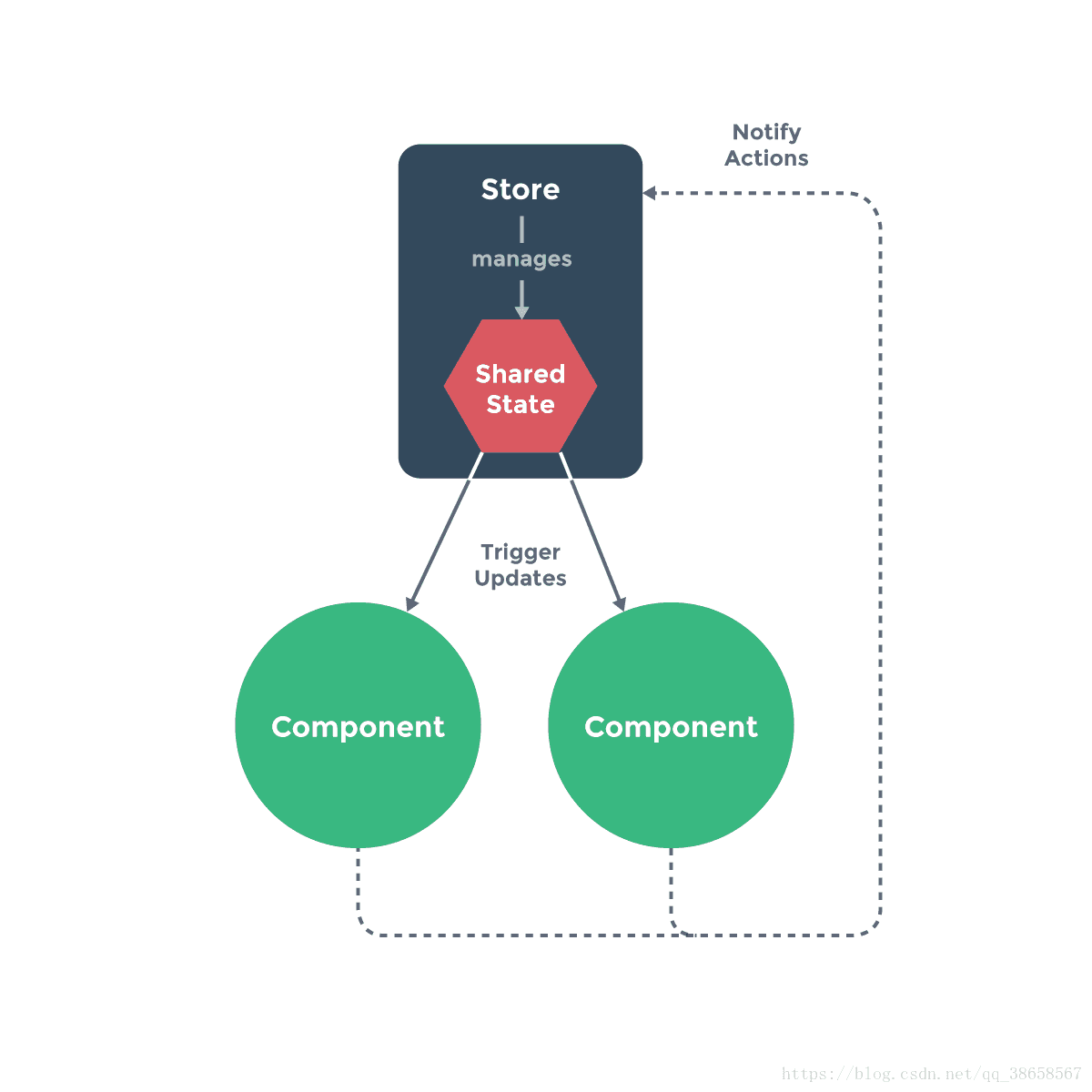原文链接:https://blog.csdn.net/qq_38658567/article/details/82847758
状态管理
一、状态管理(vuex)简介
vuex是专为vue.js应用程序开发的状态管理模式。它采用集中存储管理应用的所有组件的状态,并以相应的规则保证状态以一种可预测的方式发生变化。vuex也集成到vue的官方调试工具devtools extension,提供了诸如零配置的time-travel调试、状态快照导入导出等高级调试功能。
Vuex 的思想
当我们在页面上点击一个按钮,它会处发(dispatch)一个action, action 随后会执行(commit)一个mutation, mutation 立即会改变state, state 改变以后,我们的页面会state 获取数据,页面发生了变化。 Store 对象,包含了我们谈到的所有内容,action, state, mutation,所以是核心了
官方demo
1 const store = new Vuex.Store({ 2 state: { 3 count: 0 4 }, 5 mutations: { 6 increment (state) { 7 state.count++ 8 } 9 } 10 })
二、状态管理核心状态管理有5个核心,分别是state、getter、mutation、action以及module。
分别简单的介绍一下他们:
1、state
state为单一状态树,在state中需要定义我们所需要管理的数组、对象、字符串等等,只有在这里定义了,在vue.js的组件中才能获取你定义的这个对象的状态。
2、getter
getter有点类似vue.js的计算属性,当我们需要从store的state中派生出一些状态,那么我们就需要使用getter,getter会接收state作为第一个参数,而且getter的返回值会根据它的依赖被缓存起来,只有getter中的依赖值(state中的某个需要派生状态的值)发生改变的时候才会被重新计算。
3、mutation
更改store中state状态的唯一方法就是提交mutation,就很类似事件。每个mutation都有一个字符串类型的事件类型和一个回调函数,我们需要改变state的值就要在回调函数中改变。我们要执行这个回调函数,那么我们需要执行一个相应的调用方法:store.commit。
4、action
action可以提交mutation,在action中可以执行store.commit,而且action中可以有任何的异步操作。在页面中如果我们要嗲用这个action,则需要执行store.dispatch5、module module其实只是解决了当state中很复杂臃肿的时候,module可以将store分割成模块,每个模块中拥有自己的state、mutation、action和getter。
简单的 store 模式
1 var store = { 2 debug: true, 3 state: { 4 message: 'Hello!' 5 }, 6 setMessageAction (newValue) { 7 if (this.debug) console.log('setMessageAction triggered with', newValue) 8 this.state.message = newValue 9 }, 10 clearMessageAction () { 11 if (this.debug) console.log('clearMessageAction triggered') 12 this.state.message = '' 13 } 14 }
所有 store 中 state 的改变,都放置在 store 自身的 action 中去管理。这种集中式状态管理能够被更容易地理解哪种类型的 mutation 将会发生,以及它们是如何被触发。当错误出现时,我们现在也会有一个 log 记录 bug 之前发生了什么。
此外,每个实例/组件仍然可以拥有和管理自己的私有状态:
1 var vmA = new Vue({ 2 data: { 3 privateState: {}, 4 sharedState: store.state 5 } 6 }) 7 8 var vmB = new Vue({ 9 data: { 10 privateState: {}, 11 sharedState: store.state 12 } 13 })

三.在项目中使用
1.store文件夹一般有以下6个文件。

2.在文件中引入:(新建一个store文件夹,在文件夹下的index.js文件进行如下编写)
1 import Vue from 'vue' 2 import Vuex from 'vuex' 3 import createPersistedState from 'vuex-persistedstate' 4 Vue.use(Vuex)
3.定义简单模块:
1 const module = { 2 state: { 3 user: { 4 name: 'rookie' 5 } 6 }, 7 getters: {}, 8 mutations: { 9 setUser(state, payload){ 10 if(payload.hasOwnProperty('name')){ 11 state.user.name = payload.name 12 } 13 } 14 }, 15 plugins: [createPersistedState()] 16 }
上面是一个简单的vuex,在vuex中对应的store应用,在store中包含组件的共享状态state和改变状态的方法(暂且称作方法)mutations。注意state相当于对外的只读状态,不能通过store.state.user.name来更改,使用store.commit方法通过触发mutations改变state。
在页面中获取记录的值name为rookie:
1 mounted(){ 2 console.log(this.$store.state.user.name); 3 }
store.state为获取store中的值,此时在my页面中打印出来的值为rookie,而我们想要修改name的值,则需要借助store.commit方法来触发mutations:
this.$store.commit('setUser',{name: 'kuke_kuke'})
在mutations中找到setUser,第二个参数payload为传入的对象{name: ‘kuke_kuke’},调用方法hadOwnProperty来判断传入的对象是否有name属性,从而修改state中的值,此时在页面中再次打印user.name的值为’kuke _ kuke’。
最后导出模块:
const store = new Vuex.Store(module)
export default store
在main.js中获取模块并使用:
import store from './store'
new Vue({
store
})